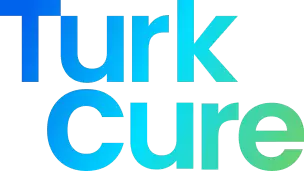I. Introduction
The demand for rhinoplasty in men has been steadily increasing over the past decade. It’s evident that the standards of masculine beauty have evolved as well, with specific criteria that differ from those applied to women.
Men’s motivations for seeking rhinoplasty are diverse, ranging from addressing therapeutic and corrective issues within the nose to enhancing the overall aesthetic appeal of their nasal features. Additionally, men’s noses are exposed to various factors that can significantly contribute to damage.
In this blog, we will provide an in-depth exploration of male rhinoplasty, highlighting the distinctions between male and female rhinoplasty procedures, the pre-surgery preparations, the surgical process, post-operative care tailored for male patients, and answers to common questions.
What Drives Men to Consider Rhinoplasty?
In general, men’s motivations for rhinoplasty can be classified into six distinct categories. Notably, most of these motivations are closely tied to health and functionality concerns. Many men may not be aware of underlying functional issues in their noses that can lead to a spectrum of problems, including breathing difficulties, sleep disturbances, and related issues such as headaches, chronic nasal congestion, fatigue, nighttime snoring, and persistent runny nose.
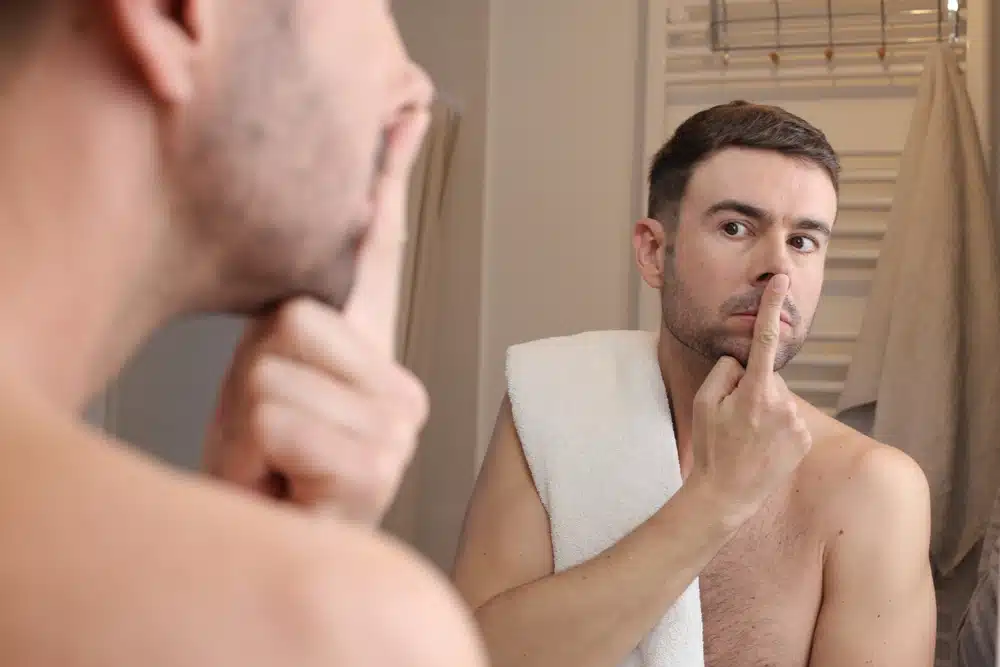
We will provide a comprehensive list of these concerns along with explanations. It’s important to recognize that men may also experience nasal injuries resulting from work-related incidents, sports activities, accidents, confrontations, military service, and other factors.
Table.1 List of Nasal Issues in Men
| Nasal Turbinates Hypertrophy | Enlargement of the nasal turbinates can obstruct the nasal passages and lead to breathing difficulties | Chronic Postnasal Drip | Excessive mucus production and drainage at the back of the throat can result in a persistent cough, throat-clearing, and irritation. | Nasal Congestion Due to Medications | Certain medications, such as nasal decongestant sprays, when overused, can lead to a condition known as rhinitis medicamentosa. | Smell and Taste Disorders | Conditions affecting the olfactory system can lead to a decreased or altered sense of smell and taste. | Nasal Septal Perforation | A hole or opening in the nasal septum can result in symptoms like whistling sounds during breathing, nosebleeds, and nasal dryness. | Nasal Bleeding (Epistaxis) | Frequent nosebleeds can be caused by various factors, including dry air, injury, or underlying medical conditions. | Rhinitis | Inflammation of the nasal mucosa can lead to symptoms like a runny or stuffy nose and sneezing. | Nasal Fractures | Trauma to the nose, such as a broken nose, can result in issues like nasal deformities, difficulty breathing, and pain | Chronic Nasal Congestion | : Persistent nasal congestion, often due to a variety of causes, can affect breathing and overall comfort | Nasal Allergies | : Allergic rhinitis can cause symptoms such as sneezing, runny nose, and nasal congestion when exposed to allergens like pollen, dust, or pet dander | Nasal Polyps | Noncancerous growths in the nasal or sinus passages can obstruct airflow and lead to symptoms like congestion and decreased sense of smell | Sinusitis | Inflammation or infection of the sinuses can cause symptoms such as nasal congestion, facial pain, and sinus pressure. | Deviated Septum | When the nasal septum, the wall that separates the nostrils, is crooked or deviated, it can lead to breathing difficulties and congestion | Snoring and Sleep Apnea | : Nasal issues, such as nasal congestion or obstruction, can contribute to snoring and sleep apnea, a condition characterized by interrupted breathing during sleep |
Let’s explore the aesthetics that drive male rhinoplasty and how this procedure impacts various aspects of the male nose. Many men find motivation for rhinoplasty in the desire to reduce a prominent dorsal hump, ultimately achieving a smoother and more balanced nasal profile. Correcting a crooked or misaligned nose is another common goal, leading to enhanced facial symmetry. Refining the width of the nose is sought by some to achieve an overall more balanced appearance. Moreover, achieving a more defined or less upturned nasal tip is a prevalent aspiration among those undergoing male rhinoplasty.
However, it’s not merely about appearances. The role of confidence and self-esteem cannot be overstated. Rhinoplasty can be a transformative journey for many men, instilling a renewed sense of self-assurance. It addresses insecurities tied to the appearance of their noses, making a profound difference in their overall confidence.
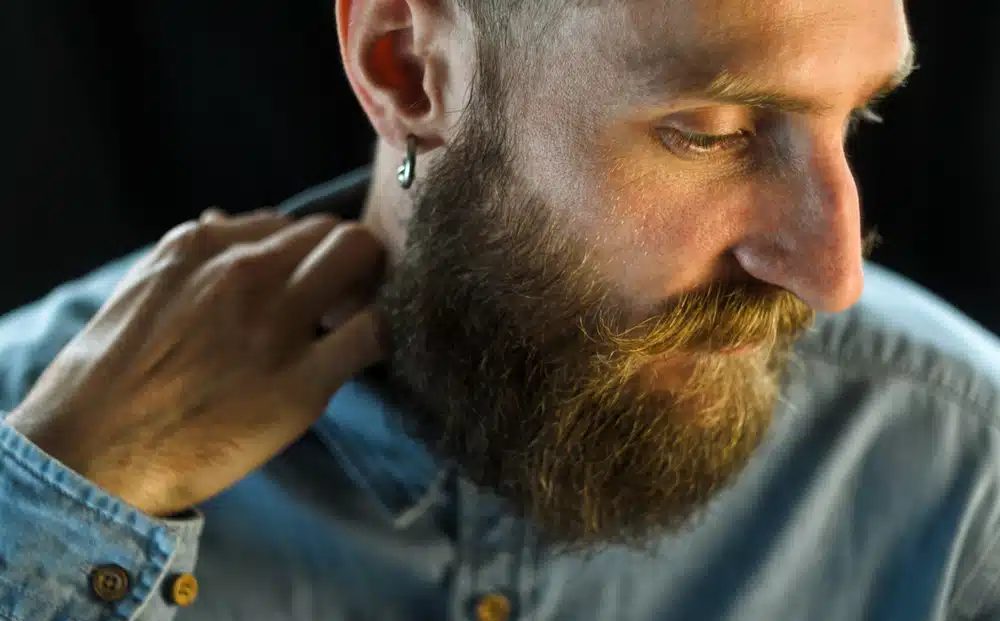
When considering the most common cause of rhinoplasty in men, aesthetic concerns typically top the list. These include dorsal hump reduction and nasal tip refinement, among other aesthetic objectives.
Nevertheless, this doesn’t encompass the entirety of motivations for male aesthetic nose surgery. Age-related changes also play a significant role in the decision to undergo rhinoplasty. As men age, the shape and appearance of their noses can undergo transformations. Rhinoplasty emerges as a solution to address age-related concerns, such as drooping nasal tips and sagging skin, effectively restoring a more youthful and refreshed appearance.
Summary:
Motivations for Male Rhinoplasty:
- Men seek rhinoplasty for health, aesthetic, and confidence reasons, addressing issues like breathing difficulties and aesthetic goals such as reducing dorsal humps. Many are unaware of underlying nasal problems causing symptoms like headaches. The desire for a balanced appearance and improved self-esteem makes rhinoplasty transformative for men, with age-related changes also motivating a more youthful look.
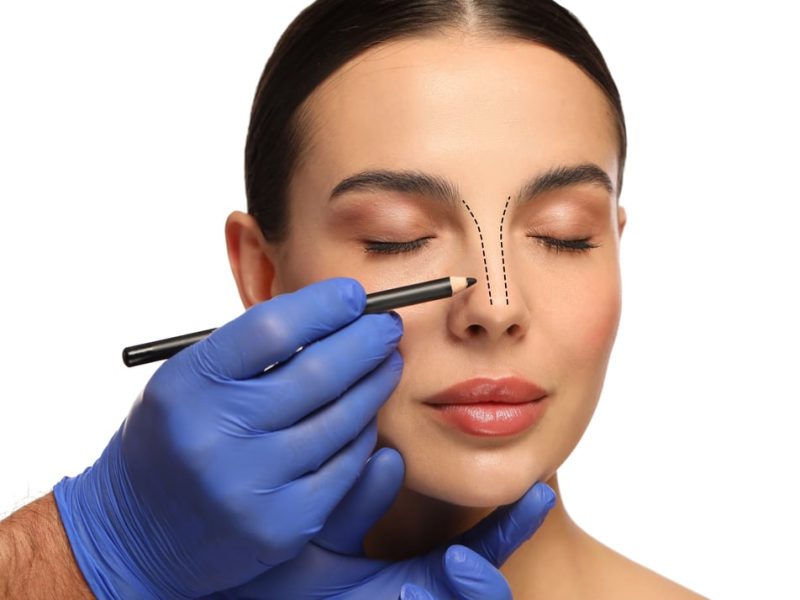
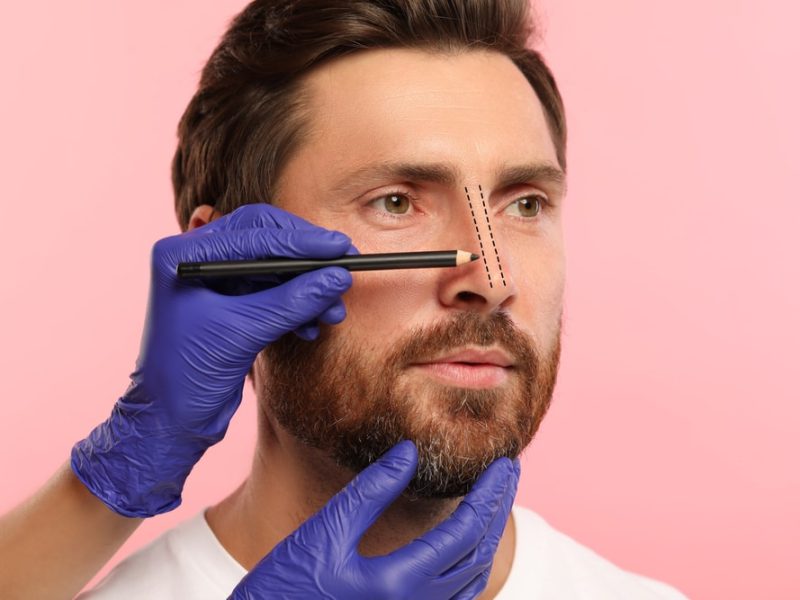
What Is The Difference of Cosmetic Nose Surgery In Both Genders?
When considering the distinctions in cosmetic nose surgery for both men and women, it’s essential to delve into gender-specific considerations. These considerations hold a crucial place in the realm of rhinoplasty, as they guide the surgical approach, ultimately aligning the results with an individual’s unique desired appearance and facial harmony.
This personalized approach acknowledges that men and women often have distinct aesthetic goals when it comes to rhinoplasty. It’s about understanding the nuances of each gender’s preferences and tailoring the procedure accordingly. By recognizing these differences, the surgeon can deliver outcomes that not only address functional aspects but also align with the patient’s vision of their ideal aesthetic, enhancing overall satisfaction and confidence.
Table 2. Comparison Between Male & Female Rhinoplasty
| Aesthetic Goals | |
|---|---|
| Men often seek more conservative changes to maintain a strong and masculine appearance. Common goals include straightening a crooked nose, reducing a prominent dorsal hump, and achieving proportional nasal features. | Women may seek a broader range of changes, including a smaller, more refined nose, a slightly upturned tip, and increased overall facial softness. The emphasis may be on achieving a harmonious, feminine appearance. |
| Nasal Size | |
| Men typically prefer a larger and more prominent nasal structure to maintain a masculine appearance. Reducing nasal size must be done conservatively. | Women often prefer a smaller, more delicate nose, which may involve reducing the size and refining the features. |
| Nasal Tip | |
| Men typically desire a well-defined and less rotated (upturned) nasal tip to maintain a masculine look. | Women often prefer a slightly upturned and more refined nasal tip, which can create a youthful and feminine appearance. |
| Bridge and Hump | |
| Reducing a prominent dorsal hump and creating a straighter bridge is common. | Women may opt for a smoother nasal profile with a subtle curve, which can create a softer and more feminine appearance. |
| Overall Facial Harmony | |
| Both men and women should consider how rhinoplasty affects their overall facial harmony. The nose should complement the rest of the facial features, and a skilled surgeon will ensure that the results appear natural and balanced. | |
| Skin Thickness | |
| Skin thickness varies between genders, with men typically having thicker nasal skin. Surgeons consider this difference when planning and performing rhinoplasty to achieve optimal results. | |
II. Consultation Phase

A. Initial Consultation with Surgeon
Naturally, the first step for someone who wants to do male cosmetic nose surgery is consultation with a surgeon. Below is a list of questions that you can ask the doctor during the meeting:
Questions On Professional Background Of The Surgeon
- Are you board-certified in plastic surgery or otolaryngology (head and neck surgery)?
- How long have you been performing rhinoplasty procedures?
- Can you show me before-and-after photos of aesthetic nose surgery patients with similar concerns?
- Can you provide references from previous patients who have undergone rhinoplasty with you?
Things to Ask About Rhinoplasty Procedure
- What are the surgical techniques you use for rhinoplasty for male patients?
- Will the nose job for men be performed as an open or closed procedure?
- What type of anesthesia will be used for the surgery?
- How long does the nose operation procedure for men typically take?
- What are the expected results of the rhinoplasty in terms of aesthetics and functionality?
- Are my goals and expectations realistic and achievable with the procedure?
- How is the surgery personalized to meet my specific concerns and preferences?
- What are the potential risks and complications associated with cosmetic nose operations for men?
- How do you minimize the risks and complications during the procedure?
- What is the expected recovery period after a male nose job, and when can I resume normal activities?
- What are the total costs of the rhinoplasty for men, including surgeon’s fees, facility fees, anesthesia costs, and any additional expenses?
- Do you offer financing options or payment plans for the procedure?
On Nose Job Post-Care
- Can you provide post-operative care instructions and guidelines for recovery?
- If open rhinoplasty is recommended, what should I expect in terms of scarring, and how is it managed?
- What is the post-operative care plan, and how many follow-up appointments will be needed?
- What should I expect during the healing process, and what signs of complications should I watch for?
- If I have breathing issues, how can the surgery improve my nasal airflow, and will it address related problems?
- If I have had a previous rhinoplasty, do you foresee any need for revision surgery or adjustments?
- Where will the surgery take place, and is the facility accredited with a skilled medical team?
- How can I reach you or your office in case of post-operative questions or concerns?
- When will I be able to see the final results, and how soon can I return to my regular activities?
B. Discussing the Patient's Aesthetic Goals
In the comprehensive list of consultation questions for men seeking rhinoplasty, one of the most pivotal stages leading up to the surgery is the articulation of your desires and expectations for the procedure. This step holds immense importance because an adept surgeon will provide you with candid insights into your nasal issues, distinguishing between real concerns and perceived ones.
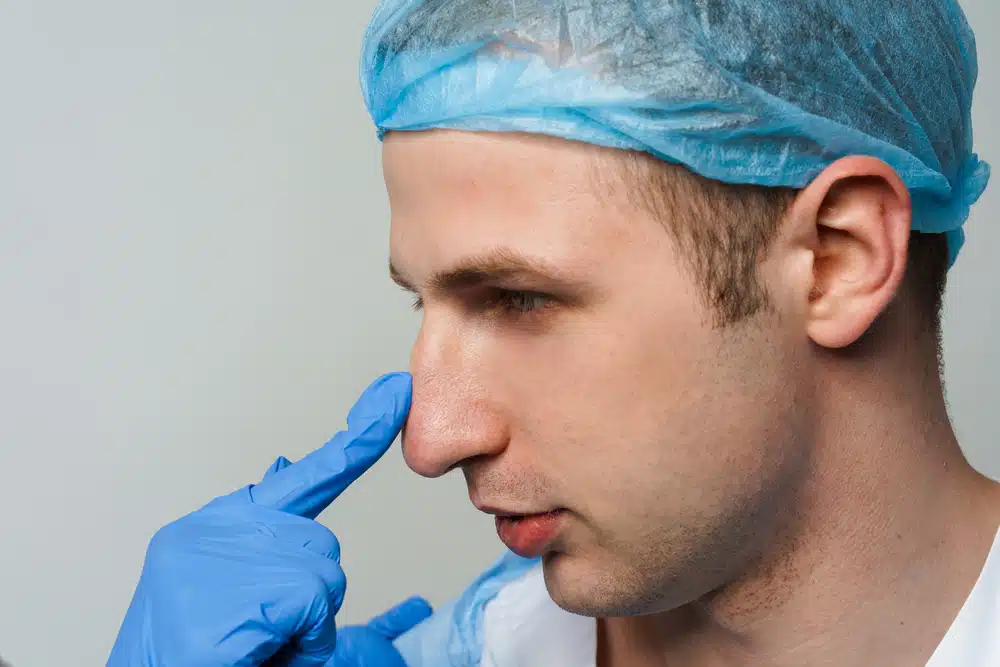
To achieve this, a thorough examination of both the interior and exterior of your nose will be conducted. The surgeon will also outline the extent to which your wishes can be realized, painting a clear picture of your prospective final nose.
It appears that most men share a common aspiration during this process – to preserve the essential masculine characteristics of their noses. This approach aims to maintain a harmonious proportion between the nose and the other facial elements while addressing any visible flaws or functional challenges.
Nevertheless, personal preferences inevitably play a significant role, and your vision for your nose may deviate from the norm. Regardless of your specific inclinations, it’s crucial to engage in open dialogue with your surgeon to reach a mutual understanding of the intended outcome of the surgery.
Dive into the finer details of your desired result. Request the surgeon to showcase examples of their previous nose surgeries, fostering discussions about each facet of the nose, from the bridge to the envisioned appearance of the nasal tip. This meticulous examination will pave the way for a tailored surgical plan that aligns perfectly with your expectations and aesthetic aspirations.
Summary:
Aesthetic Goal Discussion in Rhinoplasty Consultation:
- Men commonly aim to retain masculine features, achieving balance with facial elements and addressing flaws. Personal preferences are discussed openly to align the vision with the intended surgical outcome. Requesting examples of previous surgeries ensures a tailored plan that precisely meets expectations.
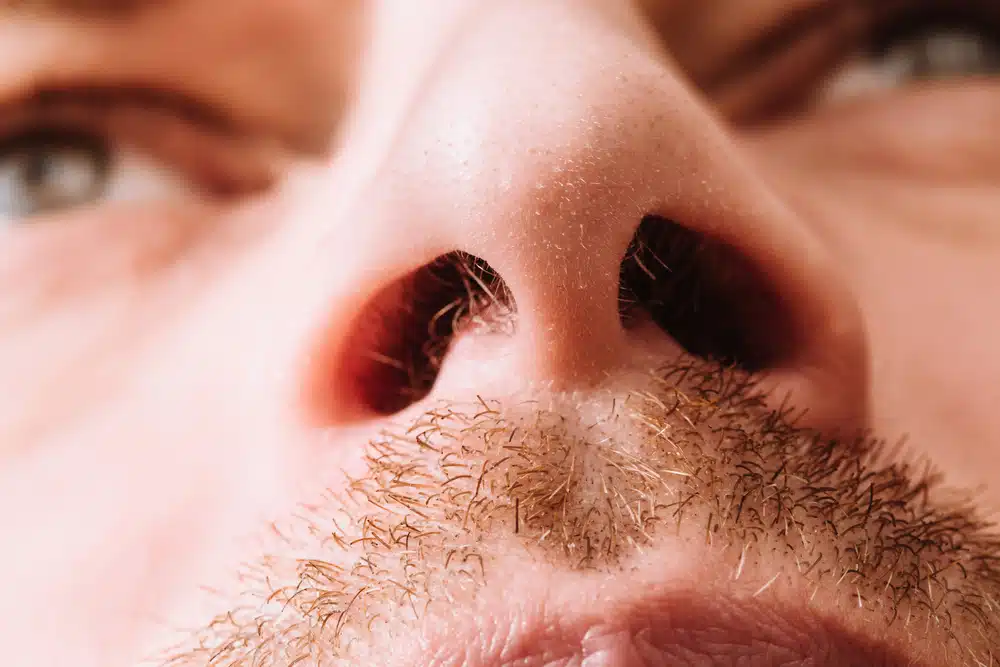
C. Evaluation of Nasal Structure
The surgeon conducts a physical examination of the patient’s nose to understand what is wrong and what can be improved. Such examination includes both the inner structure and the outer one and it includes assessing various aspects of the nose, such as:
Nasal Structure:
The surgeon evaluates the size, shape, and symmetry of the nose. They look for deformities, bumps, deviations, or any structural issues that may be affecting the patient’s breathing or aesthetics.
Nasal Airways:
The functionality of the nasal airways is crucial. The surgeon assesses if there are any obstructions or abnormalities that might hinder proper airflow. Issues like a deviated septum or nasal valve collapse can affect breathing and are taken into consideration.
Facial Proportions:
The surgeon examines how the nose fits into the overall facial proportions. They assess the relationships between the nose, chin, and other facial features to ensure that any adjustments made to the nose will harmonize with the patient’s unique facial structure.
Scarring and Previous Surgeries:
If the patient has undergone prior nasal surgeries, the surgeon checks for any scarring or structural changes resulting from these procedures. This information is crucial for planning a revision rhinoplasty if necessary. Therefore, if you have had a second rhinoplasty before, you must bring it up.
Summary:
Nasal Structure Evaluation
- The surgeon assesses both the inner and outer aspects of the nose, examining size, shape, and symmetry, and checking for deformities affecting aesthetics and breathing.
- Nasal airway functionality is crucial, in addressing obstructions or abnormalities.
- The evaluation considers how the nose fits into overall facial proportions and includes checking for scarring and structural changes from previous surgeries, crucial for planning revisions.
D. Examination of Skin Thickness and Texture
The thickness and quality of the patient’s skin covering the nose can significantly impact the surgical approach. Thicker skin may require different techniques than thinner skin to achieve the desired results. Normally, in comparison with female patients, the skin type of men is thicker. Let’s see how a male’s skin texture can impact the results of the nose surgery for cosmetic purposes:
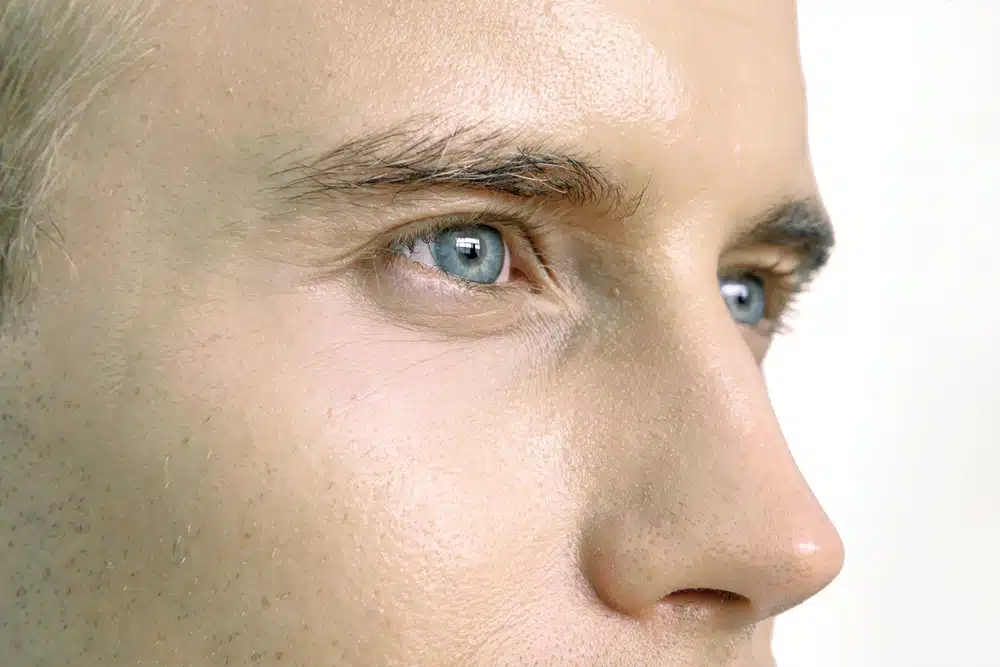
Male Skin In Rhinoplasty
Thicker skin can pose both advantages and challenges for rhinoplasty as such skin can often provide better coverage for changes made to the underlying nasal structures, which is particularly beneficial when correcting irregularities. It can help hide imperfections or irregularities in the cartilage and bone, making the results look more natural.
On the other hand, thicker male skin in rhinoplasty also poses challenges as it can be less responsive to changes in the underlying structure. Achieving fine details or subtle refinements, such as creating a very defined nasal tip, can be more challenging. It might take longer for the swelling to subside and reveal the final results in individuals.
Male rhinoplasty candidates should also notice the fact that the potential for scarring also depends on their skin quality. Some people may be more prone to noticeable scarring after surgery, while others might heal with less visible scars. An experienced surgeon always aims to minimize scarring during a male nose operation, and relying on his/ her experience regarding the skin characteristics he/she will make the best decisions.
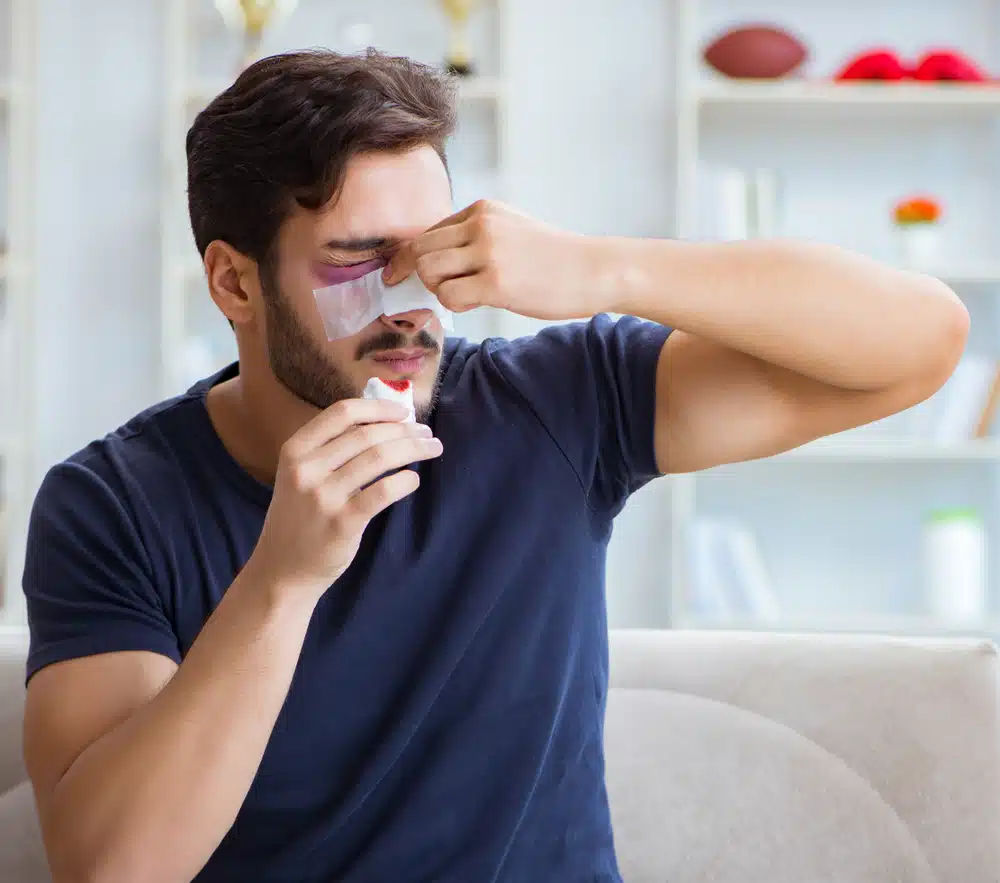
Other Characteristics of Thick Male Facial Skin
The other aspect affected by the skin thickness in male rhinoplasty is post-operative swelling and recovery process. Thicker skin typically retains more fluid and may swell more after surgery which can extend the duration it takes for the final results to become fully visible.
Yet, another factor influenced by the skin texture is the aesthetics of the nose. For example, thick, oily skin may appear shinier and potentially less defined, which could affect the perceived shape and contour of the nose. Conversely, thin skin may allow for more detailed definition but can also make irregularities more noticeable.
Your skin texture may also pose limitations in tip definition. Achieving a refined and well-defined nasal tip can be more challenging in individuals with thick skin because such skin type may not drape as tightly over the newly shaped cartilage and can mask some of the finer details. It might be necessary to perform additional procedures or use specific techniques to achieve the desired tip definition.
Finally, cartilage and bone shape are affected by the skin type of men when undergoing nose surgery. Here it is the appearance of the underlying cartilage and bone that is at stake. Thicker skin might not transmit the subtle nuances of the nasal framework as clearly as thin skin. Surgeons must account for these variations during the planning and execution of the rhinoplasty. You might ask how it is done.
Surgeons may employ different rhinoplasty techniques based on the patient’s skin characteristics. For instance, certain techniques, such as tip-plasty, are tailored to address the nasal tip, which can be more challenging with thicker skin. And even the choice of an open or closed rhinoplasty technique might also be influenced by skin characteristics.
Summary:
Skin Thickness in Male Rhinoplasty
- Thicker skin in male rhinoplasty offers better coverage but poses challenges in achieving fine details. Potential scarring varies with skin quality, and thicker skin leads to prolonged swelling. Skin texture impacts aesthetics, influencing choices like open or closed techniques. Surgeons adapt techniques based on skin characteristics to refine the nasal tip and consider variations in cartilage and bone appearance.
E. Exploring Any Functional Concerns
After assessing the nasal structure and skin properties, there comes the assessment of breathing concerns. If the patient has breathing issues, such as nasal obstruction, the surgeon may recommend additional tests, like a CT scan or nasal endoscopy, to further assess the internal nasal structures and the exact cause of the problem.
Some surgeons use computer imaging technology to provide a visual representation of potential post-operative results. This helps the patient visualize the changes and ensures that their expectations align with what the surgery can realistically achieve.
III. Operation & Post-Op Day

A. How to Prepare Yourself for Rhinoplasty in Turkey?
Preparing for your male rhinoplasty in Turkey involves several important steps to ensure a smooth and successful experience. At TurkCure, we prioritize effective communication with our patients to address any questions or concerns they may have. Here’s how you can get ready for your rhinoplasty journey:
Initial Consultation:
Before your trip to Turkey, we will arrange at least one in-person meeting between you and your surgeon. We understand the significance of establishing trust and open communication with our patients. During this consultation, you will have the opportunity to discuss your goals and expectations with your surgeon.
Online Assessment:
To assist in your preparation, we will conduct an online assessment based on photos you provide from various angles. This helps us better understand your unique needs and requirements.
Pre-Surgery Directions:
Once your surgery date is confirmed and the customized package details are shared with you, your doctor will provide a list of instructions to follow before the procedure. This list may include the following key points:
- Medication Guidelines: You will receive information about which medications to avoid before surgery, particularly blood thinners. Managing bleeding during cosmetic surgery is essential, and this precaution helps mitigate the risk.
- Medication Disclosure: It’s crucial to inform your doctor about all the medications you are currently taking. This includes any prescriptions, over-the-counter drugs, or supplements.
- Medical History Review: Your surgeon will also review your medical history. This step is important as certain medical conditions, such as high blood pressure, heart issues, or bleeding disorders, can impact your eligibility for the procedure. Your latest medical reports will be examined to ensure your safety during surgery.
Along with the general preparation tips mentioned above, there are other things to consider, such as:
Quit Smoking and Alcohol:
It’s essential to discontinue both smoking and alcohol consumption at least 10 to 14 days before your surgery. You should continue to abstain from them for a duration determined by your doctor. Both smoking and alcohol have detrimental effects on your immune system, which can impede the healing process.
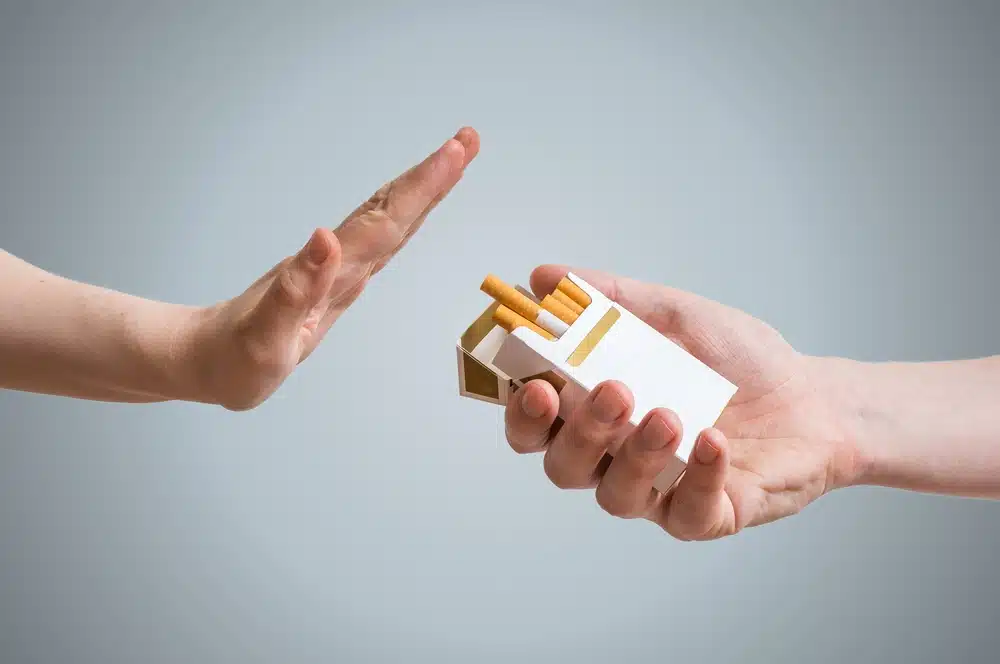
Fasting Before Surgery:
On the day of your nose surgery, do not consume any food or beverages within 8-12 hours before the procedure. This fasting period is vital to ensure your safety during the operation.
Clothing Choice:
Opt for a loose-fitting shirt to wear on the day of your rhinoplasty surgery. Following the surgery, you will spend one night in the hospital. Once you return to your hotel, there may be some mild nose bleeding for the next 24-48 hours. Wearing a loose shirt will facilitate easy changing if needed.
Duration of Stay:
Remember that our rhinoplasty for the male package in Istanbul includes comprehensive accommodation services. Therefore, you won’t require any specific prior preparation at home. Your stay in Istanbul will last for 6 full days or a week, ensuring you have all the necessary support during your recovery period.
Alternative Option:
If you choose to have your nose cosmetic surgery in your home country, especially if you live alone, it’s advisable to make some preparations. Ensure your home is clean and organized, so you won’t need to perform chores or prepare meals for yourself during the initial stages of recovery.
Summary:
Preparation for Male Rhinoplasty in Turkey
- Initiate the process with an in-person and online assessment to establish clear communication. Once the surgery date is confirmed, follow medication guidelines and disclose current medications. General preparation includes quitting smoking and alcohol, fasting on the surgery day, wearing a loose shirt, and planning a 6-day stay in Istanbul with accommodation. For those opting for surgery in their home country, ensure a clean and organized home, especially if living alone.
B. Post-Operative Care
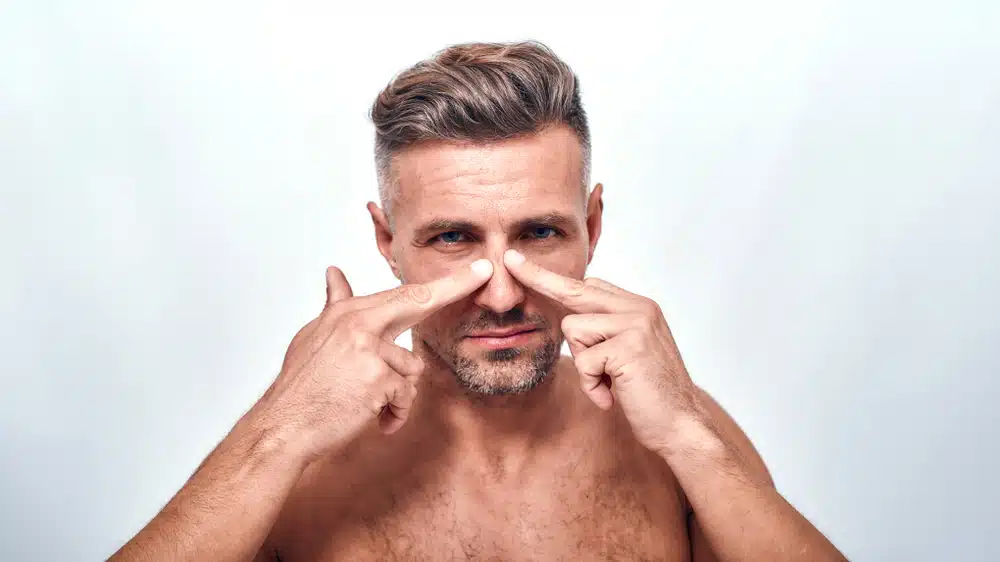
How Does Your Rhinoplasty Recovery Look Like?
Once your rhinoplasty surgery is complete, you may be wondering what changes to anticipate and how to care for your newly enhanced nose properly. Additionally, you might have questions about the ideal sleeping, sitting, and eating positions, as well as what activities to avoid and which are safe. Let’s explore the answers to these common questions that often arise for men undergoing nose surgery.
1. Bruising:
Bruising is a condition where, although painless, discoloration appears on various facial areas, such as the nose and around the eyes, in shades ranging from dark purple to green and yellow. Although the extent of bruising varies significantly among individuals, it’s possible that your face may exhibit more swelling following male rhinoplasty.
One effective remedy for these situations is the application of a cold compress. If bruising appears on your face, complete resolution may take up to two weeks.
2. Swelling:
One common side effect after undergoing a nose aesthetics surgery for males is nasal swelling. Today, the use of traditional nasal packing (tampons) is less common. Instead, surgeons typically place splints or silicone tampons inside your nasal passages to help maintain your new nose’s shape. As a result, you’ll not only experience some nasal swelling but also some discomfort. However, there’s no need to worry, as the day after your surgery, your surgeon will remove all of these components. The splints, in particular, may remain in your nose for a maximum of one week.
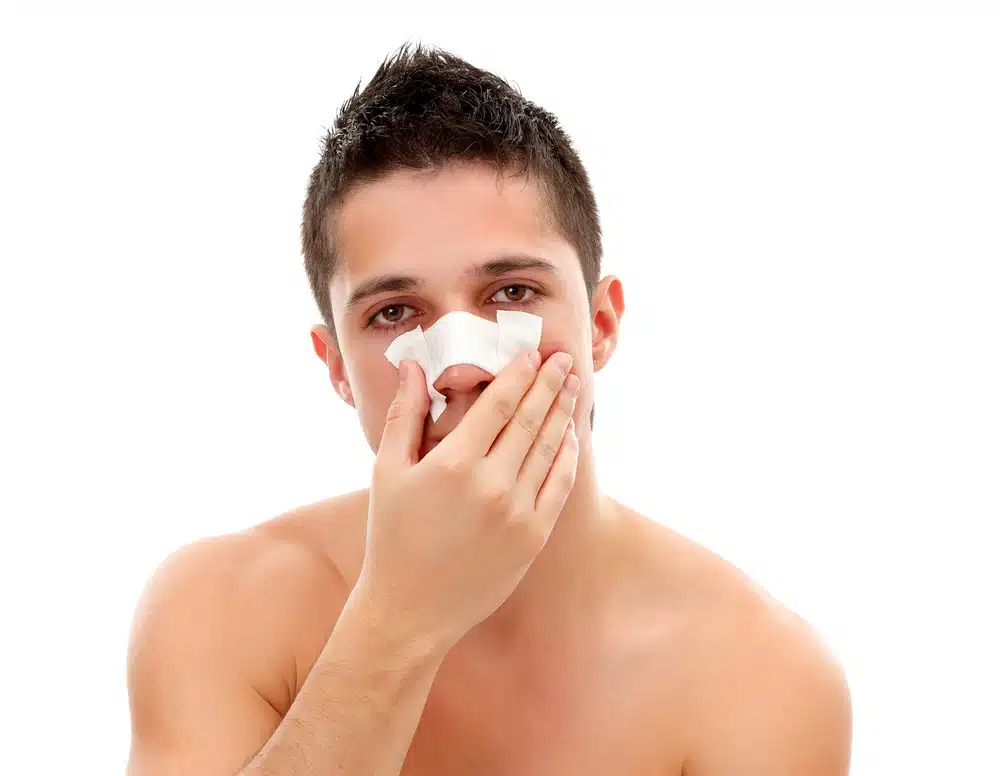
To minimize swelling and bruising, the best strategy is to lie down or sit back on your bed, allowing blood to flow more easily. To prevent excessive and prolonged swelling, it’s advisable to avoid heavy exercise for a few weeks. For instance, activities like weightlifting, swimming, and vigorous sports should be avoided. Nevertheless, light activities such as walking are generally acceptable. Just be cautious when walking in crowded areas with bicyclists, skaters, or children to avoid any accidental bumps to your nose that could cause harm.
3. Eating
As you may know, due to the bandage on your nose during the first few days after rhinoplasty, you won’t be able to eat solid foods easily. Your nose needs to remain as still as possible, and attempting to eat hard foods, especially those requiring chewing and jaw movement can put pressure on your nose. So, for a few days, forget about steaks, bread, and the like, and opt for lighter alternatives like soups or very simple foods.
If you’re using TurkCure’s rhinoplasty packages for men in Istanbul, you don’t need to worry because suitable meals will be provided during your hotel stay, and you can always get in touch with our support team to consult regarding your meals.
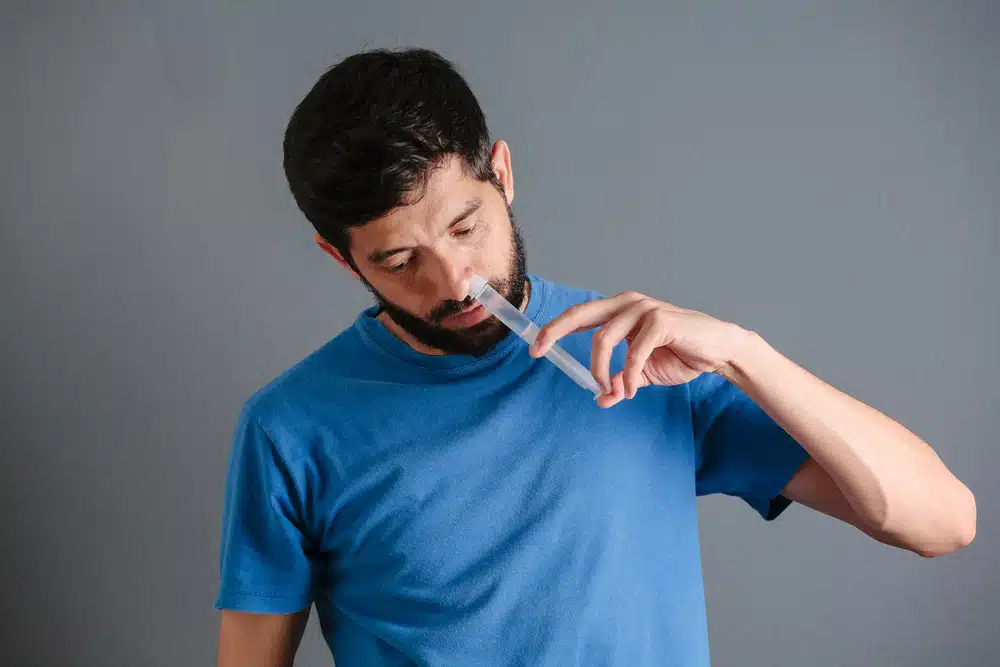
4. Keeping the Nose Clean
Maintaining a clean nose involves cleaning any traces of dried blood clots or scabbed blood inside the nostrils. To do this, you must be very careful and, without applying pressure, use a Q-tip for cleaning. One of the best solutions for wound cleaning is hydrogen peroxide. Simply dip the Q-tip into a small amount of the solution to moisten it, then gently apply it to the scabbed blood. Repeat this process for a few days until there are no more blood clots left.
Remember that you should not wet your face or stand directly under the shower until the bandage on your nose is removed and the splints are taken out.
5. Saline Spray
Saline spray is one of the most effective methods to keep your nose moist and clear away scabs and buildup. In various cosmetic surgeries, including male rhinoplasty, maintaining a clean surgical site significantly aids in expediting the healing process. Saline spray can be used to moisturize your nose when you’re experiencing dryness, assist in removing blood scabs, and more, as explained below.
Moisturizing Your Nose:
If you ever feel dryness in your nose during the healing process, saline spray can provide much-needed moisture. This helps prevent discomfort and promotes better healing.
Removing Blood Scabs:
After surgery, blood scabs may form inside your nose. Saline spray can help soften and loosen these scabs, making it easier to remove them without causing any harm or discomfort.
Special Situations, like Air Travel:
In certain situations, like air travel, saline spray becomes even more valuable. Flying, especially in low-humidity environments, can exacerbate nasal dryness and discomfort. By using saline spray during your journey, you can keep your nasal passages comfortably moist.
Whether you’re in the early stages of recovery or traveling, saline spray is an essential tool for maintaining your nasal health after rhinoplasty. It not only facilitates a more comfortable healing process but also supports the overall success of your surgery.
6. Don't Blow Your Nose
Don’t Blow! Your nose is very delicate and hasn’t fully taken its final shape after rhinoplasty surgery. Therefore, it’s crucial to avoid applying any pressure to it. You might be tempted to blow your nose due to the presence of scabs and a congested feeling inside it, but it’s still too early for that.

As mentioned earlier, we discussed the use of saline spray. Instead of blowing, spray it on the areas where scabs have formed to moisten them, making it easier for them to detach from your nose. Never use your fingers on the sides of your nose to build pressure inside your nose, as this can disrupt the process and extend the time it takes for your nose to heal. Be patient and let the healing process proceed gradually without direct interference for about a month – it’s worth it.
Also, if you’ve had a nose job for men during the cold season, take precautions to avoid catching a cold! Until at least three to six months have passed since your surgery, your nose may not have gained the necessary strength. Therefore, if you sneeze or cough, it can exert extra pressure on your nose.
7. Flying
After approximately a week since your male rhinoplasty surgery in Istanbul, it’s now time to board your flight back home. Although there are no signs of pain or significant bleeding after the procedure (only some blood oozing), and no surgical splints left in your nose, there’s a potential issue that may arise, especially during long flights: nasal dryness. Be sure to have your saline spray with you to keep your nasal cavities moist during the flight.
Apart from nasal dryness, another concern some people experience during flights is swelling in various parts of the body. Since your nose naturally retains some swelling after cosmetic surgery, you might notice that it has increased even more. So, you might want to consider refraining from flying until your nose settles and the swelling subsides.
Additionally, to minimize the risk of unintentional contact between your nose and other people or objects, it’s a good idea to choose a window seat when booking your flight. You can also recline your seat slightly to breathe more comfortably. Avoiding seats in the aisle row is advisable, as these are high-traffic areas for flight attendants and other passengers.
Summary:
Post-Operative Care for Male Rhinoplasty
- After male rhinoplasty, expect bruising and temporary swelling, with nasal packing removed a day after surgery. Opt for soft foods to avoid nose pressure, and use a saline spray for moisturizing and comfort during travel. Refrain from blowing your nose; instead, use saline spray for scabs, allowing gradual healing over a month. During flights, use a saline spray to combat nasal dryness and choose a window seat for minimal contact and discomfort.
Special Care Note:

Nasal Taping for Men Post-Rhinoplasty
One of the critical post-operative steps after cosmetic nose operation is proper nasal taping. Nasal taping serves the dual purpose of reducing swelling and shaping the final form of your nose when done correctly.
However, applying nasal taping requires specific principles. Alongside essential measures like refraining from strenuous physical activities, avoiding hot weather, or taking hot showers, and staying away from enclosed, heated spaces like saunas and jacuzzis – proper taping and removal of the tapes play a crucial role in reducing swelling and preventing scar tissue formation inside your nasal passages due to the strain on the nasal skin.
Particular attention should be paid to men seeking rhinoplasty, as thicker male skin tends to be less flexible in terms of shaping and molding. Individuals with thin skin in their nasal area tend to have an easier time after surgery because their nasal cartilage and skin can bend more easily. However, if your skin is thicker, you’ll need to contribute more actively to shaping it.
How long should I keep my nose taped?
After removing the cast, it’s highly beneficial to continue nose taping for an extended period, ideally within the range of three to six months. If you prefer not to have your nose taped during work or social activities, you can limit this practice to nighttime by removing the bandage every morning. Below, we’ll provide guidance on the correct way to apply and remove nasal tapings.
How to Apply Nasal Taping:
To start, you’ll need a specialized tape like 3M Micropore Tape and a pair of scissors. It’s important to do this facing a mirror since it’s not a task that can be performed blindly.
- Begin by cutting a piece of adhesive tape, just under an inch in length.
- Start applying it at the highest point of your nose, the bridge, and gently press it onto your face using your fingertip.
- Then, similarly to the initial piece, cut the next piece slightly larger and overlap it to cover half of the previous tape, affixing it to your face.
- Continue this process toward the tip of your nose.
- It’s not necessary to bandage the entire tip of the nose, but instead, you can cut a larger piece and attach it underneath your nose without covering the nostrils.
- Lift the edges of the tape upwards and shape them to create a U shape.
- Repeat this process from the bottom to the top, attaching two layers of tape to your nose.
How to Remove Nasal Tapes:
Never rush the removal process; instead, take your time when detaching the tape. Pulling it off quickly can lead to increased swelling and the potential scarring of underlying tissues due to the skin being pulled.
- Be sure to use a Q-tip soaked with a special adhesive remover.
- Begin by moistening the adhesive with the liquid, making it easier to detach.
- Then, slide the Q-tip gently under the tape without applying pressure, and pull it off starting from the edges.
- Follow this procedure patiently until you’ve removed the final piece of tape.
These steps will help you apply and remove nasal tapes effectively, promoting optimal healing and results during your rhinoplasty in men’s recovery.
Summary:
Nasal taping
- Nasal taping is vital post-rhinoplasty for reducing swelling and shaping the nose’s final form, especially with thicker male skin. It requires consistent efforts for three to six months post-cast removal, ideally at night. Use specialized tape for application, starting from the bridge and forming a U shape towards the tip. During removal, take your time using a Q-tip soaked in adhesive remover, ensuring effective and patient application and removal for optimal healing and results in the recovery phase.
D. Monitoring for Complications
Monitoring for Complications in Men Following Rhinoplasty
Could complications arise after male rhinoplasty? What are the potential issues following a male nose operation that you should be aware of? While these issues are rarely encountered, having knowledge about them can be helpful.
1. Anesthesia Complications and Allergic Reactions:
In male rhinoplasty, general anesthesia is commonly used. Although extremely rare, complications such as vomiting, difficulty in breathing, severe nausea, or other unusual issues can occur following anesthesia. In the case of any of these symptoms, it is essential to promptly contact your surgeon.
2. Infection:
The most significant and serious issue that may occur after cosmetic nose surgery is the development of an infection. Indications for infection include redness, severe swelling, and ongoing pain that does not subside over time. It is necessary to consult with your surgeon immediately to address this concern.
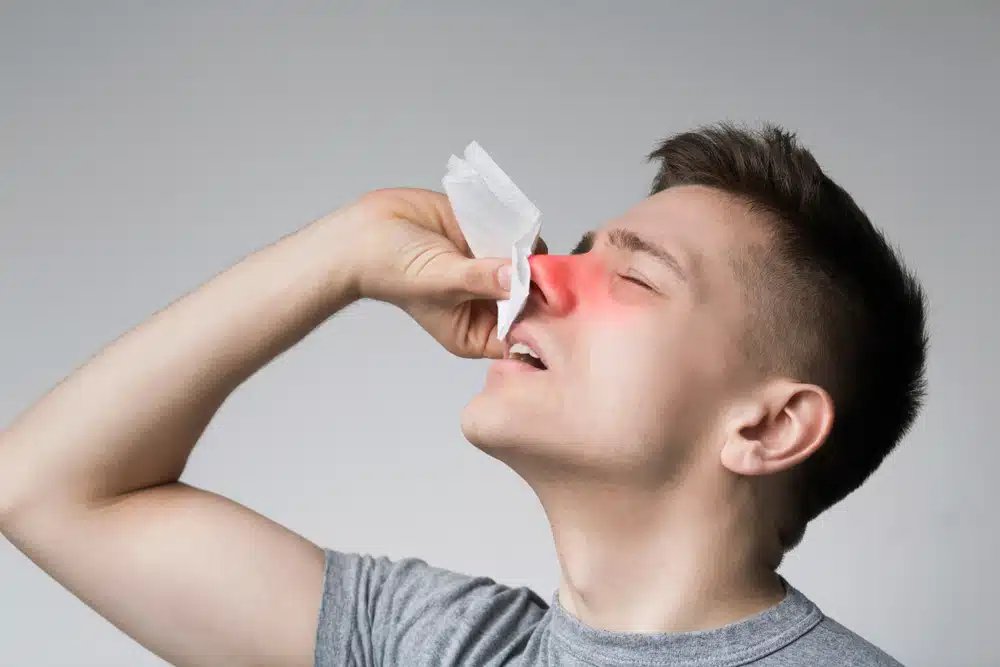
3. Excessive Bleeding:
Within the initial 24 to 48 hours after nose surgery, you might experience scattered, minimal bleeding, which is entirely normal. However, if heavy bleeding persists after two days, it is imperative to get in touch with your surgeon.
4. Swelling and Bruising:
Typically, post-nose-job swelling and bruising occur for about two to three days, with a maximum duration of one week. However, depending on the specific treatment on different areas of the nose, the recovery may extend beyond this period. In cases where bone-breaking and narrowing of the nose are required, allow at least two weeks. Under such circumstances, it’s common to experience bruising below the eyes (raccoon eyes post-rhinoplasty), which may take around 10 days to subside.
5. Breathing Issues:
One of the primary objectives of rhinoplasty, particularly for men, is addressing structural and functional nasal issues. Respiratory problems are among the most common reasons why men opt for nose surgery. However, if these problems persist after the operation or new issues arise, causing disruptions in breathing, it’s essential to consult with your surgeon.
6. Dissatisfaction with the Surgical Outcome:
If you’ve invested enough time in research and evaluation before choosing your surgeon, you can minimize the likelihood of post-operative dissatisfaction with your results.
However, being satisfied with the aesthetics of the procedure is a subjective and personal matter, and it may not meet your expectations.
In such a situation, you should consider the next best course of action based on your circumstances. It might be worth exploring options like a second rhinoplasty or alternative treatments such as liquid rhinoplasty.
Rest assured that even if the initial outcome falls short of expectations, there is still a chance to achieve the nose that aligns with your desires.
Summary:
Complications in Men Following Rhinoplasty
- Anesthesia: Rare, contact surgeon promptly for issues.
- Infection: Urgent consultation for redness, swelling, and pain.
- Excessive Bleeding: Normal within 48 hours; heavy bleeding after two days needs immediate attention.
- Swelling and Bruising: Typically 2-3 days (up to 1 week), may extend with specific treatments.
- Breathing Issues: Persistent problems post-operation need consultation; rhinoplasty addresses nasal structure.
- Dissatisfaction: Minimize risk with research and surgeon choice. Explore alternatives if dissatisfied; chance for achieving desired results even if the initial outcome falls short.
VII. Conclusion
In this comprehensive guide on male rhinoplasty for 2023, we have explored the growing trend of men seeking nasal enhancement for both functional and aesthetic reasons. Male rhinoplasty is motivated by a range of factors, from addressing health-related concerns such as breathing difficulties and nasal obstructions to refining the aesthetics of the male nose.
We delved into the key distinctions between male and female rhinoplasty, highlighting the importance of tailoring surgical approaches to meet individual goals and facial harmony. It is clear that men often desire more conservative changes to maintain a strong and masculine appearance, focusing on aspects like dorsal hump reduction and achieving proportional nasal features.
The consultation phase was thoroughly examined, with an emphasis on open communication between the patient and the surgeon. The importance of articulating aesthetic goals and expectations was stressed, allowing for a tailored surgical plan that preserves masculine characteristics while addressing specific concerns.
The evaluation of nasal structure, skin thickness, and texture was explored, with an emphasis on how these factors impact the surgical approach, potential scarring, and recovery process. The differences in skin thickness between men and women play a crucial role in the surgical plan and the final results.
Male Rhinoplasty in Turkey, Post-Care & Complications
The preparation phase for male rhinoplasty in Turkey was also discussed, emphasizing the importance of careful planning and communication with the surgeon. Factors such as medication guidelines, medical history review, lifestyle changes, and clothing choices were detailed to ensure a successful and safe surgical experience.
The post-operative care phase involves managing common concerns such as bruising, swelling, and nasal taping. Patients are advised to maintain a clean nose, use saline spray, and refrain from blowing their nose during the healing process. Special care is also taken when applying and removing nasal tape, considering the impact of skin thickness on shaping and molding the nose.
Monitoring for complications is an essential aspect of post-operative care, with attention to potential issues related to anesthesia, infection, excessive bleeding, swelling and bruising, breathing problems, and overall satisfaction with the surgical outcome. While complications are rare, it’s crucial for patients to be informed and in regular communication with their surgeon to address any concerns promptly.
In conclusion, rhinoplasty in men is a transformative journey that offers not only aesthetic improvements but also the restoration of self-confidence. The growing demand for male rhinoplasty reflects the evolving standards of beauty and the desire for both health-related and aesthetic enhancements in the male nose. With careful planning, personalized approaches, and skilled surgeons, men can achieve their desired results while maintaining their unique masculine characteristics.
Summary:
Conclusion
- Male rhinoplasty, driven by both functional and aesthetic motives, is on the rise in 2023. This trend is marked by distinctions from female rhinoplasty, emphasizing conservative changes for a strong, masculine appearance.
- Open communication in consultations tailors surgical plans, considering nasal structure, skin thickness, and texture. Planning for male rhinoplasty in Turkey involves meticulous preparation.
- Post-operative care manages concerns like bruising and swelling, with rare complications monitored.

